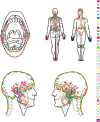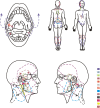Evaluation of Orofacial and General Pain Location in Patients With Temporomandibular Joint Disorder-Myofascial Pain With Referral
- PMID: 31191438
- PMCID: PMC6549135
- DOI: 10.3389/fneur.2019.00546
Evaluation of Orofacial and General Pain Location in Patients With Temporomandibular Joint Disorder-Myofascial Pain With Referral
Abstract
Introduction: Pain is an emotional experience. As a subjective feeling, it is associated with pathophysiological processes occurring in the central nervous system, which in turn may negatively affect the psychophysical function, cognitive abilities, level of functioning and quality of life. The Aim: The aim of the study was to assess orofacial and general pain location in patients with temporomandibular joint disorder-myofascial pain with referral. Materials and Methods: The study group consisted of 50 randomly selected, generally healthy people with complete natural dentition (37 women and 13 men) at the age of 23.36 ± 2.14 years, referred to the Department of Prosthodontics of the Medical University. All patients underwent clinical examination according to the Diagnostic Criteria for Temporomandibular Disorders (Axes I and II). The subjects were classified as people with myofascial pain with referral. The evaluation of severity of temporomandibular disorders was based on the Temporomandibular Disorder Pain Screener and the Graded Chronic Pain Scale. In order to assess orofacial and general pain location, a bodychart drawing of pain was used. Results: The study group indicated 40 different areas of the body affected by pain. 2-3 isolated pain locations were declared by a total of six subjects. One person identified 17 affected areas. Forty four people reported pain in at least four regions of the body. 70% of patients suffered from pain within the right masseter muscle. Pain of the left masseter muscle was noted in 68% of cases. Cervical ailments were reported by 56% of people. Pain of the left temporomandibular joint was observed in 68% of patients, and of the right one in 54%. Conclusion: The patients with myofascial pain with referral suffer from general ailments in different regions of the body. Only the frequency of pain in the right masseter muscle and right temporomandibular joint differed with respect to gender. The suggestion that the prevalence of pain in other areas of the body varies between men and women has not been confirmed. Due to a small sample size, such differences cannot be excluded. Further studies in this area are needed.
Keywords: headache; myofascial pain; orofacial pain; referred pain; temporomandibular disorder.
Figures



Similar articles
-
Smiling, Yawning, Jaw Functional Limitations and Oral Behaviors With Respect to General Health Status in Patients With Temporomandibular Disorder-Myofascial Pain With Referral.Front Neurol. 2021 May 24;12:646293. doi: 10.3389/fneur.2021.646293. eCollection 2021. Front Neurol. 2021. PMID: 34108927 Free PMC article.
-
The Prevalence and Overlaps of Temporomandibular Disorders in Patients with Myofascial Pain with Referral-A Pilot Study.Int J Environ Res Public Health. 2021 Sep 18;18(18):9842. doi: 10.3390/ijerph18189842. Int J Environ Res Public Health. 2021. PMID: 34574764 Free PMC article.
-
The role of soft tissue mobilization in reducing orofacial and general complaints in a patient with Kimmerle anomaly and temporomandibular joint disorder: A case report.Cranio. 2021 Jan;39(1):74-87. doi: 10.1080/08869634.2018.1560616. Epub 2019 Jan 4. Cranio. 2021. PMID: 30609909
-
Muscle pain in the head: overlap between temporomandibular disorders and tension-type headaches.Curr Opin Neurol. 2007 Jun;20(3):320-5. doi: 10.1097/WCO.0b013e328136c1f9. Curr Opin Neurol. 2007. PMID: 17495627 Review.
-
Orbital pseudotumor presenting as a temporomandibular disorder: A case report and review of literature.J Am Dent Assoc. 2018 Nov;149(11):983-988. doi: 10.1016/j.adaj.2018.05.016. Epub 2018 Jul 25. J Am Dent Assoc. 2018. PMID: 30055762 Review.
Cited by
-
Transcriptomic Analysis of Trigeminal Ganglion and Spinal Trigeminal Nucleus Caudalis in Mice with Inflammatory Temporomandibular Joint Pain.J Pain Res. 2022 May 23;15:1487-1502. doi: 10.2147/JPR.S364887. eCollection 2022. J Pain Res. 2022. PMID: 35633917 Free PMC article.
-
Temporomandibular Myofascial Pain Syndrome-Aetiology and Biopsychosocial Modulation. A Narrative Review.Int J Environ Res Public Health. 2021 Jul 23;18(15):7807. doi: 10.3390/ijerph18157807. Int J Environ Res Public Health. 2021. PMID: 34360099 Free PMC article. Review.
-
Changes and Associations between Cervical Range of Motion, Pain, Temporomandibular Joint Range of Motion and Quality of Life in Individuals with Migraine Applying Physiotherapy: A Pilot Study.Medicina (Kaunas). 2021 Jun 17;57(6):630. doi: 10.3390/medicina57060630. Medicina (Kaunas). 2021. PMID: 34204366 Free PMC article.
-
Oxidative imbalance as a co-player in jaw functional limitations and biopsychosocial profile in patients with temporomandibular disorder-myofascial pain with referral.Front Neurol. 2025 Jan 3;15:1509845. doi: 10.3389/fneur.2024.1509845. eCollection 2024. Front Neurol. 2025. PMID: 39830201 Free PMC article.
-
Myofascial Pain Syndrome: An Update on Clinical Characteristics, Etiopathogenesis, Diagnosis, and Treatment.Muscle Nerve. 2025 May;71(5):889-910. doi: 10.1002/mus.28377. Epub 2025 Mar 20. Muscle Nerve. 2025. PMID: 40110636 Free PMC article. Review.
References
-
- Slade GD, Conrad MS, Diatchenko L, Rashid NU, Zhong S, Smith S, et al. . Cytokine biomarkers and chronic pain: association of genes, transcription, and circulating proteins with temporomandibular disorders and widespread palpation tenderness. Pain. (2011) 152:2802–12. 10.1016/j.pain.2011.09.005 - DOI - PMC - PubMed
LinkOut - more resources
Full Text Sources
Medical
Research Materials

